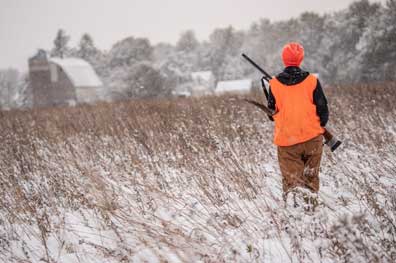Hunting pheasants, ruffed grouse, squirrels or rabbits offers opportunities to enjoy the Minnesota outdoors as temperatures fall and snow blankets the landscape.
“Small game hunting remains a great way to stay active or even start a new hunting tradition as weather changes and winter sets in,” said James Burnham, hunter and angler recruitment coordinator with the Minnesota Department of Natural Resources.
Anyone looking to learn more about how or where to hunt can find more information and how-to guides on the DNR’s learn to hunt pages.
Snowy Fields And Pheasants
From grasslands to frozen wetlands, pheasant hunters can find good numbers of birds during late-season hunts. Pheasants that had found cover in standing crops now congregate in tall grass or cattail marshes.
As it gets colder and cattail sloughs and wetlands begin to freeze, hunters should be able to reach areas they couldn’t before. Hunters should always put safety first and stay off thin ice.
“Pheasant hunting involves a good amount of walking so it’s easier to stay warm, and it’s a fun way to get into the fresh air and sunshine when days are shorter and we tend to spend more time indoors,” Burnham said.
On December 1, the daily bag limit increased to three roosters, with a possession limit of nine roosters. The season is open through Sunday, January 3. Shooting hours are 9 a.m. to sunset. More information is available on the DNR pheasant hunting page.
Winter Woods And Ruffed Grouse
Hunters more at home in the cover of forest can enjoy the effort of trekking through snow and the challenge of hunting ruffed grouse during a season that lasts through January 3.
Wintertime grouse hunters may find success during the golden hour, that last hour before sunset when ruffed grouse move out of their snow roosts to feed.
Grouse season has a daily bag limit of five grouse and a possession limit of 10. Shooting hours are a half hour before sunrise to sunset. More information is available on the DNR grouse hunting page.
Sunny Days For Squirrels And Rabbits
Quick-moving squirrels and rabbits provide additional challenge in the woods, in a season that continues into the depths of winter after other hunting seasons have ended. Through Sunday, February 28, hunters can shoot gray and fox squirrel, cottontail rabbit, jack-rabbit and snowshoe hare.
“Challenge, plenty of action and a chance at excellent table fare await hunters who get out in the winter for squirrels and rabbits,” Burnham said. “A walk through the woods on a nice sunny day can keep you sharp and it’s a lot of fun.”
Seeking out squirrels can be an inexpensive way to introduce youth to hunting. Squirrels can be particularly active in the winter because they are in their breeding season. Rabbits are fast-moving and tend to be found in thick cover, such as brush piles, thorn tangles and briars.
The daily limit is seven for squirrels and 10 for cottontail rabbit and snowshoe hare (combined), and the possession limits are twice the daily limits. Jackrabbit has a daily limit of 1 and a possession limit of 3. More information is available on the DNR small game hunting page.
Public Hunting Land
Minnesotans have a wide variety of public land available for hunting.
- Walk-In Access lands are popular among pheasant hunters. There are 28,000 acres of Walk-In Access land spread over 250 areas in western and south central Minnesota. Hunters of all ages must possess a $3 Walk-In Access validation to use these lands. The 2020 Walk-In Access atlas is posted on the DNR website.
- Ruffed grouse management areas have good potential for producing grouse and are managed to promote suitable habitat conditions for these species. They range in size from 400 to 4,800 acres, and an interactive map showing their locations is available on the DNR website.
- Minnesota has 1,440 wildlife management areas with 1.29 million acres of habitat across the state. Hunters can locate wildlife management areas using the WMA finder.
- These and additional types of public land can also be found on the DNR Recreation Compass.
Photo courtesy of the Minnesota DNR.








